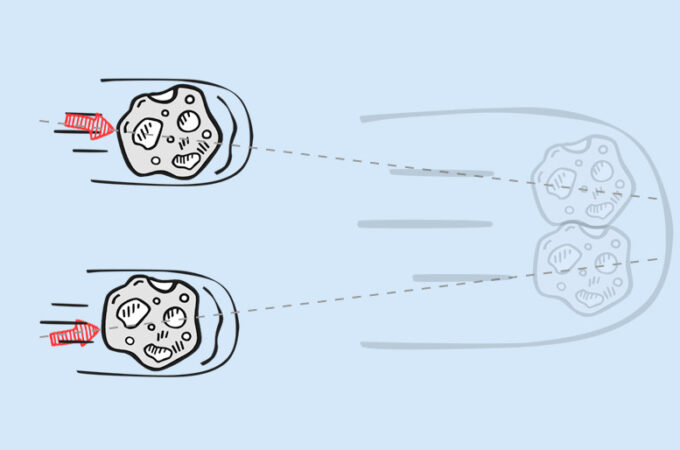In the late 90’s I was working for a video game developer in Austin. One day, Frank, a member of my team, walked into my office and grabbed a whiteboard marker.
“I’ve got you figured out”, said Frank.
“Oh really?”, I replied
“Yup. Let’s imagine there are two asteroids traveling through space in a parallel path. The goal is to make the two asteroids touch and keep them touching. One approach is to shove them really hard towards each other. That takes a tremendous amount of force and when they hit, two things are going to happen. 1) There’s going to be a lot of damage and 2) the asteroids are going bounce away from each other with a lot of force. Holding them together will require a lot of effort.”
“But that’s not what you do”, Frank said. “You don’t limit yourself by time. So, you pick a point in the future that you want the asteroids to touch. Then you give them a little nudge so they touch in the future. Eventually, they’ll touch each other. When they do, the reaction is minimal, there’s little damage and it takes very little effort to keep them from separating again. You’re a nudger.”
I’m a nudger. I really liked that. Several years later, I was working in the Boston area. I was explaining to Nick about different management styles and how I’m a nudger.
When I finished the explanation, Nick looked at me and said, “That’s close but not quite right.”
“Why?”, I asked.
“Because you don’t pick a single goal. You pick several different points in the future where the asteroids could touch. Each outcome is equally acceptable, and you don’t care which one happens, as long as you eventually reach the goal. If you see you’re not going to hit the first spot, you adjust your strategy and nudge them again towards the second spot, and so on. Since time isn’t a constraint, you’re successful regardless of when the asteroids touch, as long as they do.”
I really liked that analogy because it is 100% accurate. I always like to have multiple plans. If Plan A doesn’t work out, then we move on to Plan B. If Plan B doesn’t work, then we move on to Plan C. I’ve never needed more than two contingency plans and Plan A is rarely the one we go with. I can count the number of times that Plan A worked on just my ten fingers. Clearly sometimes time is important but that simply gets worked in as part of the plans. The point is that things are always changing and what looks like a perfect plan may not be what is ultimately successful
It recently occurred to me that the analogy also describes the difference between Liberals and Conservatives.
Liberals are “shovers” and are only concerned with now. They want immediate gratification and are forcing the country toward the change they want to make. Their approach takes a tremendous effort and causes a lot of damage when it happens. They believe that the United States is fundamentally flawed. They aren’t concerned with the damage they cause because they see it as necessary to achieve their goals. The damage resulting from the collision will inevitably result in many people pushing back. Which means it’s going to take a lot of effort to keep those people under control.
Conservatives, on the other hand, are “nudgers” and are trying to carefully move toward a better future. They have goals they’re trying to meet, but they also realize that the goals may change. So, they give things a nudge. If something changes, they’ll change their plans and then nudge things a little more. They see that the United States is fundamentally sound, so only small adjustments are necessary. When they reach a goal, minimal, if any, damage has resulted, and it takes little effort to keep everything on track because nearly everyone is already heading in the same direction.
Liberals don’t anticipate what the future will bring because they don’t care what it is. They only care that they get what they want, and that they get it now. Conservatives realize that it’s impossible to predict the future and, to be successful, you have to be both patient and adaptable.
Newton’s Third Law of Motion says that for every action, there is an equal and opposite reaction. The more force you use, the more force will push back. By shoving with a huge force, Liberals are pushing us toward a collision that guarantees people will push back, fragment and separate. Conservatives nudge toward a goal with the minimal force required to help ensure that we all work together to safely get everyone to the same place at the same time.


